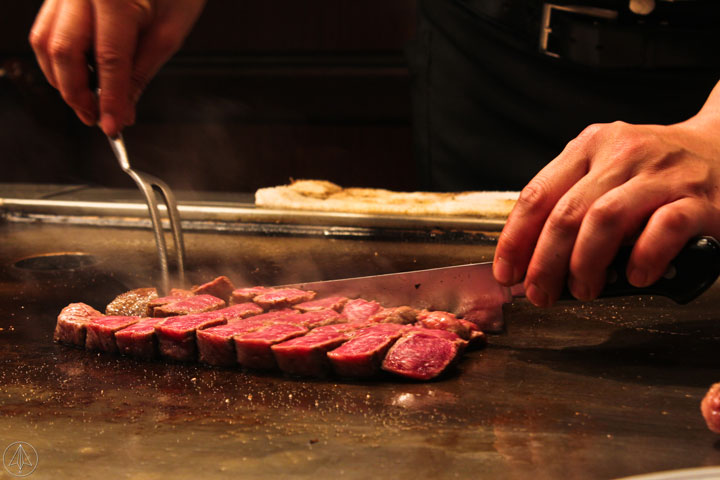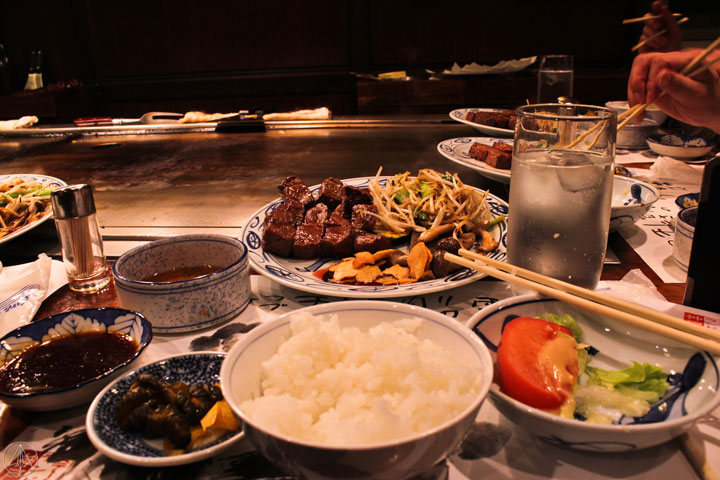Although we don’t do much food blog, every time we travel, our main goal is to try the country’s local food. We love eating too much that we don’t think on what to write or what to share about it—we just want to enjoy what we are eating. As I’ve mentioned in my previous blog (read here) there is this one food that deserves its own entry.
Our first visit in Japan was in Kansai region. In Kansai, their cuisine mainly uses beef as compared to Kanto cuisine which prominently uses pork.
If you like eating anything beef, you must have encountered the term Wagyu. Wagyu is any cattle that are bred in Japanese style. “Wa” means Japanese and “Gyu” means cow. Wagyu has three major black strains: Taijiri or Tajima, Fujiyoshi and Kedaka.
One of most famous Wagyu beef is the Kobe beef—which is from the Tajima strain. Raised in Kobe, Hyogo Prefecture, the meat is known for its flavorful, tender, fatty and well-marbled texture meat. It can be cooked as a steak, sukiyaki, shabu-shabu, teppanyaki or sashimi.
The traditional way of raising a Tajima-gyu is said to include playing of classical music during their feeding time as it was believed the music can help the cattle relax and incorporate the eating with positive emotion. Beer is also included in their diet during hot months when the cattle most likely lose its appetite. It makes the cattle regain its lost appetite. Another technique is confining the cattle. From birth, they are confined in small pens to minimize their movements, this way, they can keep their muscles tender but are given a daily massage to relieve stress due to stiffness.
Can you imagine being pampered, not have anything to do with your whole life and being given food with beer, only to end up in someone else’s belly? HAHA ok. I’ll stop before you lose your appetite.
We searched for the most recommended Kobe beef restaurant in Kobe considering both quality and budget.
Upon researching, we were lead to Steak Land Kobe. Just a few minutes away from Hankyu Sannomiya Station. You should be able to see a signage lightbox hanging from above. We were lucky enough to line up for only 30 minutes as most people say they queue for around an hour. You can reserve seats in advance especially if you are in a large group but walk-ins are fine too, just be prepared to wait to be seated.
We were seated in a teppanyaki bar counter and was handed a menu.
That time we were not aware that there are different grades of Kobe beef. All along we thought we can just order Kobe beef and that’s it. The waitress was kind enough to explain to us the differences of the set meals listed in the menu.

We were only interested to try the Kobe beef (that’s the main point why we went there in the first place.) So we are not quite sure what the others are.
Kobe beef steak dinner is grade A4 marble grade Kobe beef while the Special Kobe beef steak dinner is grade A5. In marbling grade, the higher the marble, the higher the fat content.
On the other hand, special Kobe beef loin steak dinner and Special Kobe beef fillet steak dinner are grade A5 but in different cut or was taken from the loin part; this muscle does the least work and it is considered to be the most tender part of a beef.
All sets come with Hors-d’oeuvres, special soup, seafood, grilled vegetables, salad, bread or rice, dessert, with coffee or an orange juice.
We chose the A4 grade as we wanted a bit more of meat. Best to order in medium rare!
Upon ordering, we were first served with our juice, rice, salad and appetizers. The chef first warmed the pre-fried garlic chips followed by the mushrooms and other vegetables.

Then he will start cooking your meat of choice and use a copper cover for a minute or two. Then the chef will slowly slice your Kobe beef into cubes.




And TADAAAA!

I can’t describe enough how good the smell and taste was. True as what is marketed for, it was really fatty and tender and IT DOES MELT IN YOUR MOUTH. This is an A4 grade! I just can’t imagine how much more for A5? You can really tell the difference from a normal beef—it was too tasty for a beef that is not marinated.
Is it worth it? For me, YES. It’s not just about the taste, it’s the total experience. There are some food that you can’t just forget how good it was.
When in Japan and when you want to try Kobe beef, try it in Kobe. Kobe beef is from Kobe. As simple as that. But when you’re not in Japan, be careful of false promises. I’ve read a lot of articles that Kobe beef sold or served outside Japan is not a legitimate Kobe beef but rather just a regular Wagyu beef.
Like they say “All Kobe is a Wagyu, but not all Wagyu is a Kobe”
by:

F*ckin?amazing issues here. I am very happy to see your article. Thank you a lot and i’m looking ahead to contact you. Will you please drop me a mail?
This actually answered my drawback, thank you!